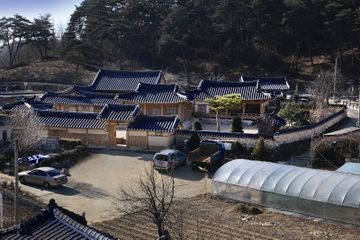"봉화 쌍벽당 종택"의 두 판 사이의 차이
(→영문) |
|||
| 46번째 줄: | 46번째 줄: | ||
Kim Eon-gu passed the state examination when he was 25 years old. However, he never took an official post, and stayed in his hometown to educate local younger scholars. His pen name “Ssangbyeok,” literally meaning “double green,” refers to pine and bamboo which stand for integrity and loyalty. | Kim Eon-gu passed the state examination when he was 25 years old. However, he never took an official post, and stayed in his hometown to educate local younger scholars. His pen name “Ssangbyeok,” literally meaning “double green,” refers to pine and bamboo which stand for integrity and loyalty. | ||
| − | This house is said to have been built when Kim Gyun (1484-?), father of Kim Eon-gu, moved in this area in 1505. However, a record about the construction history of this house remains in the detached quarters, and according to this record, the main quarters was constructed in 1566 and was rebuilt in 1892. The main quarters stands high, as it was built on a slope in accordance with natural features. The detached quarters to the right of the main quarters was built during | + | This house is said to have been built when Kim Gyun (1484-?), father of Kim Eon-gu, moved in this area in 1505. However, a record about the construction history of this house remains in the detached quarters, and according to this record, the main quarters was constructed in 1566 and was rebuilt in 1892. The main quarters stands high, as it was built on a slope in accordance with natural features. The detached quarters to the right of the main quarters was built during a reconstruction in the 19th century, and features a wooden plaque with the inscription“Ssangbyeokdang,” meaning “house of double green.” A shrine made of with earth and stone walls is located behind the detached quarters. |
The buildings of this house were rebuilt and repaired several times, but the overall layout and fundamental composition preserve the original appearance and styles. | The buildings of this house were rebuilt and repaired several times, but the overall layout and fundamental composition preserve the original appearance and styles. | ||
| − | |||
=='''참고자료'''== | =='''참고자료'''== | ||
2018년 7월 30일 (월) 10:08 판
| 봉화 쌍벽당 종택 |
|
| 대표명칭 | 봉화 쌍벽당 종택 |
|---|---|
| 한자 | 奉化 雙碧堂 宗宅 |
| 주소 | 경상북도 봉화군 봉화읍 거수1길 17 |
| 지정번호 | 국가민속문화재 제170호 |
| 지정일 | 1984.01.14 |
| 분류 | 유적건조물/주거생활/주거건축/가옥 |
| 수량/면적 | 2필지/2,323㎡ |
|
|
|
해설문
국문
쌍벽당 종택은 쌍벽당(雙碧堂) 김언구(金彦球, 1507~?) 선생의 부친인 죽헌(竹軒) 김균(金筠, 1484~?) 선생이 풍산(豊山)의 구담(九潭)으로부터 연산군 11년(1505)에 이곳으로 입향(入鄕)하면서 지은 집으로 전해지고 있지만, 「쌍벽당중수기(雙碧堂重修記)」에 의하면 본채는 명종 21년(1566)에 건립하였다. 그 뒤 고종 29년(1892)에 대대적인 중수(重修)를 하였으며, 별당(別堂)인 쌍벽당은 이때 건축된 것으로 기록하고 있다.
이 고택(古宅)은 높지 않은 뒷산을 배경으로 산기슭에 자리 잡고 있다. 또한 경사진 지형(地形)을 그대로 이용하고 있어서 대문채는 낮은 곳에 있고, 본채는 높게 위치해 있다. 안채는 다른 지방에서도 볼 수 있는 ‘口’자형 살림집에 속하며 안채의 몸채가 유난히 과장(誇張)되어 있는 점이 특징적이다.
배치는 솟을대문을 들어서면 사랑채가 마주 보이고, 왼쪽으로 중문간이 있다. 중문(中門)을 들어가면 안마당에 넓은 육간대청(六間大廳)이 있는 안채가 있다. 안채의 오른쪽에 별당인 쌍벽당이 있고, 그 뒤쪽으로 토석 담장을 두른 사당(祠堂)이 조금 높이 위치해 있다.
이 건물의 경우 조선 전기에 지은 집으로서 여러 차례에 걸쳐 개보수를 하였으나, 평면과 중요한 부분의 구조는 비교적 옛날의 제도(制度)를 잘 유지하고 있어 조선 시대 주택 연구에 좋은 자료가 되고 있다.
영문용 원고
Ssangbyeokdang Head House, Bonghwa
This is the head house of the family of Kim Eon-gu (1507-?), a scholar of the mid-Joseon period. A head house is a residence passed down among the successors of a family lineage.
김언구는 25세에 생원시에 합격하였으나 선조의 유지에 따라 벼슬을 하지 않고 고향에서 후학 양성에 힘썼다. 그의 호인 ‘쌍벽’은 소나무와 대나무를 말하며, 절개와 의리라는 선비정신을 상징한다.
쌍벽당 종택은 김언구의 부친인 김균(1484-?)이 1505년 이곳으로 이주하면서 지은 것이라고 전해진다. 그러나 별당에 걸려있는 「쌍벽당중수기(雙碧堂重修記)」에 의하면, 본채는 1566년에 건립되었다. 1892년 대대적인 중수를 하였으며, ‘쌍벽당’이라는 현판이 걸려있는 별당은 이때 건축된 것이다. 여러 차례에 걸쳐 개보수를 하였으나, 평면과 중요한 부분의 구조는 비교적 옛날의 제도(制度)를 잘 유지하고 있다.
이 고택은 산기슭의 경사진 지형을 그대로 이용하고 있어서, 대문채는 낮은 곳에 있고 본채는 높게 지어져있다. 본채의 오른쪽에 별당인 쌍벽당이 있고, 그 뒤쪽으로 토석 담장을 두른 사당이 있다.
영문
This is the head house of the family of Kim Eon-gu (1507-?), a scholar of the mid-Joseon period, from the Gwangsan Kim Clan. A head house is a residence passed down among the successors of a family lineage.
Kim Eon-gu passed the state examination when he was 25 years old. However, he never took an official post, and stayed in his hometown to educate local younger scholars. His pen name “Ssangbyeok,” literally meaning “double green,” refers to pine and bamboo which stand for integrity and loyalty.
This house is said to have been built when Kim Gyun (1484-?), father of Kim Eon-gu, moved in this area in 1505. However, a record about the construction history of this house remains in the detached quarters, and according to this record, the main quarters was constructed in 1566 and was rebuilt in 1892. The main quarters stands high, as it was built on a slope in accordance with natural features. The detached quarters to the right of the main quarters was built during a reconstruction in the 19th century, and features a wooden plaque with the inscription“Ssangbyeokdang,” meaning “house of double green.” A shrine made of with earth and stone walls is located behind the detached quarters.
The buildings of this house were rebuilt and repaired several times, but the overall layout and fundamental composition preserve the original appearance and styles.
참고자료
- 유석영, 조창환, "고택순례-봉화 쌍벽당 종택", 『고창신문』, 2017년 8월 11일.
